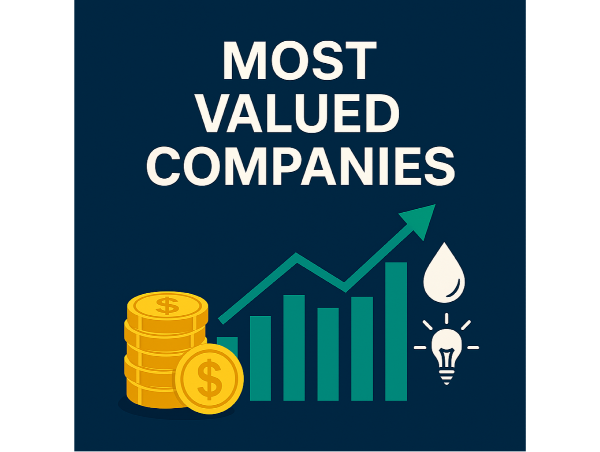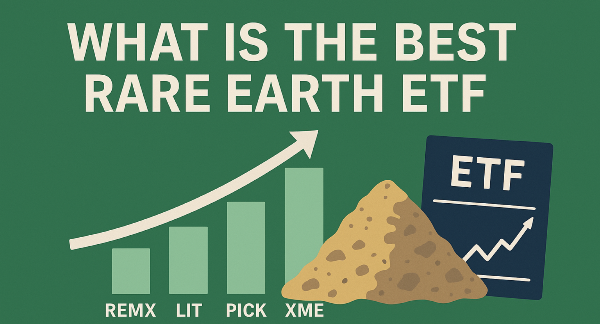Introduction
Market value represents the total worth of a company based on its stock price and outstanding shares, serving as a key indicator of financial strength and industry position. Market capitalization plays a crucial role in determining a company's size, stability, and long-term viability, influencing investment decisions and economic trends. Various factors contribute to a company's valuation, including revenue growth, profitability, technological advancements, and market demand.
Industry Leaders in Market Value
The world's most valuable companies span multiple industries, with technology, financial services, healthcare, and energy leading market capitalization rankings. Microsoft, Nvidia, and Apple dominate the technology sector, each surpassing a market cap of $3 trillion. Financial giants such as JPMorgan Chase and Visa maintain strong valuations due to their influence on global banking and digital payments. Healthcare firms like Johnson & Johnson and Eli Lilly continue to grow, driven by pharmaceutical advancements and medical innovation.
Energy companies, including ExxonMobil and Saudi Aramco, remain key players, reflecting the ongoing demand for oil and renewable energy investments. Technology remains the dominant force in market value rankings, while healthcare and energy sectors are the other strong performing sectors. Historical trends show that technology companies have steadily increased their market capitalization over the past two decades.
Technology Giants Setting the Standard
Technology giants such as Apple, Microsoft, and Nvidia continue to lead global market capitalization rankings, driven by innovation and strong financial performance. Apple maintains its dominance through a combination of premium consumer electronics, software ecosystems, and subscription services. Microsoft leverages its enterprise software, cloud computing, and AI investments to sustain growth. Nvidia has surged in valuation due to its leadership in semiconductor technology, particularly in AI-driven computing. Artificial intelligence, cloud computing, and semiconductor advancements play a crucial role in shaping technology sector valuations. Revenue models and business strategies drive the continued expansion of technology sector leaders.
Financial Titans Dominating the Market
The financial sector is dominated by major banking, asset management, and digital payment firms, shaping global market trends and investment strategies. Leading institutions such as JPMorgan Chase, Bank of America, and Visa maintain strong market positions, influencing economic stability and financial transactions worldwide. Macroeconomic factors such as interest rates and inflation significantly impact financial sector valuations, influencing profitability and investment strategies. Regulatory policies and central bank decisions further dictate market conditions.
JPMorgan Chase, Bank of America, and Visa exemplify financial sector leadership, leveraging scale and innovation to sustain market dominance. JPMorgan Chase leads in investment banking and wealth management, benefiting from diversified revenue streams. Bank of America remains a key player in retail banking and credit markets, supporting economic activity through lending and advisory services. Visa drives digital payment expansion, enhancing transaction efficiency and accessibility. These firms maintain strong balance sheets, reinforcing their influence in financial markets and market capitalization rankings.
Healthcare and Pharmaceutical Leaders
The healthcare and pharmaceutical sector plays a vital role in market capitalization rankings, driven by advancements in biotechnology, drug development, and medical innovation. Companies in this industry focus on creating life-saving treatments, vaccines, and therapies that shape global healthcare trends. Market capitalization within healthcare is influenced by regulatory approvals, research breakthroughs, and consumer demand for medical solutions. Leading pharmaceutical companies such as Johnson & Johnson, Pfizer, and Eli Lilly contribute significantly to industry market capitalization. Johnson & Johnson’s diversified portfolio spans pharmaceuticals, medical devices, and consumer health products, ensuring stability and growth.
Pfizer, known for its vaccine development and pharmaceutical innovations, has experienced substantial market cap expansion due to successful drug launches. Eli Lilly specializes in diabetes and oncology treatments, leveraging cutting-edge research to maintain its competitive edge. Trends in drug development, regulatory approvals, and healthcare expansion continue to shape the valuation of pharmaceutical companies. Regulatory approvals for new drugs and therapies significantly impact stock valuations, determining industry momentum.
Consumer Discretionary and Retail Powerhouses
The consumer discretionary sector is shaped by evolving market trends, with digital commerce and brand influence playing a significant role in market capitalization rankings. E-commerce giants leverage technology to enhance accessibility and efficiency, transforming traditional retail models. Companies with strong brand recognition and customer loyalty maintain competitive advantages, influencing stock valuations.
As digital platforms expand, firms investing in personalized shopping experiences and direct-to-consumer strategies continue to drive sector growth. Amazon, Tesla, and Disney are key players in the consumer discretionary sector, influencing global market trends and investment strategies. Amazon leads e-commerce with its extensive logistics network and cloud computing services, maintaining a market cap exceeding $2 trillion. Tesla continues to shape the automotive industry, driving electric vehicle adoption and sustainability efforts.
Disney remains a dominant force in entertainment, expanding its streaming services and content production to attract global audiences. Consumer spending trends significantly impact the valuation of consumer discretionary firms, shaping stock performance and sector rankings. Economic conditions, inflation rates, and disposable income levels determine purchasing power, influencing demand for non-essential goods and services.
Industrial and Infrastructure Giants
The industrial sector plays a crucial role in global economic development, with companies specializing in manufacturing, transportation, and logistics driving market capitalization rankings. Firms in this sector produce essential machinery, construction materials, and transportation equipment that support infrastructure projects and supply chain operations. Leading industrial firms such as Caterpillar, Honeywell, and 3M maintain strong market positions, benefiting from their diversified portfolios and global reach. Caterpillar dominates the construction and mining equipment industry, supplying machinery for large-scale infrastructure projects. Honeywell operates across multiple sectors, including aerospace, automation, and energy efficiency, positioning itself as a leader in industrial innovation.
3M, known for its manufacturing solutions, continues to expand its presence in industrial technology and materials science. Infrastructure projects and supply chain dynamics significantly impact industrial market capitalization, influencing stock valuations and sector performance. Expanding economies drive demand for industrial products, boosting revenue for companies involved in construction, transportation, and manufacturing.
Energy Sector Market Leaders
The energy sector remains a key player in global market capitalization rankings, with oil, natural gas, and renewable energy firms shaping industry valuations. Traditional fossil fuel companies continue to dominate, but the transition toward sustainable energy is influencing market trends. Market fluctuations in energy prices are driven by supply and demand shifts, geopolitical events, and technological advancements.
Leading oil and gas companies such as ExxonMobil and Chevron maintain strong market positions, benefiting from extensive production, refining, and distribution networks. ExxonMobil’s diversified operations span upstream and downstream activities, reinforcing its financial stability. Chevron, known for its global energy assets, continues to expand its presence in both traditional and renewable energy markets. The rise of renewable energy and sustainability trends is reshaping industry value, prompting companies to diversify their portfolios.
Investment Considerations for Market Leaders
Investors evaluate company valuations to refine portfolio strategies, ensuring exposure to high-growth industries while managing risk. Market capitalization rankings provide insights into sector dominance, helping investors allocate assets based on industry trends and economic cycles. Comparing risk and growth profiles across industries helps investors optimize portfolio diversification. Technology and consumer discretionary sectors typically offer high growth but come with greater volatility.
Financial services and healthcare provide stability, benefiting from consistent demand and regulatory frameworks. Industrials and energy sectors fluctuate based on macroeconomic factors, including trade policies and commodity prices. Sector rotation strategies enable investors to capitalize on shifting market trends, adjusting exposure based on economic cycles and industry performance.
Future Market Value Predictions
Emerging companies are expected to reshape market capitalization rankings, driven by advancements in artificial intelligence, clean energy, and biotechnology. Companies investing in next-generation computing, electric mobility, and personalized healthcare are likely to experience substantial market cap growth, attracting investor interest and reshaping industry valuations. The influence of technological advancements and economic transitions plays a crucial role in determining future market leaders.
Long-term investment strategies based on evolving market capitalization trends require careful sector analysis and portfolio diversification. Investors focusing on high-growth industries such as AI, healthcare, and clean energy can optimize returns while managing risk. Monitoring regulatory developments, technological breakthroughs, and macroeconomic indicators helps refine investment approaches.
Conclusion
Market capitalization rankings reflect the dynamic evolution of industries, highlighting the financial strength and strategic adaptability of leading companies. As technology continues to dominate valuations, sectors such as financial services, healthcare, consumer discretionary, industrials, and energy remain essential contributors to global markets. Emerging trends in artificial intelligence, sustainable energy, and digital commerce will influence future rankings, creating new investment opportunities. Understanding the factors shaping market value allows investors to navigate shifting economic landscapes, optimize portfolio strategies, and position themselves for long-term success.




























Introduction
Market value represents the total worth of a company based on its stock price and outstanding shares, serving as a key indicator of financial strength and industry position. Market capitalization plays a crucial role in determining a company's size, stability, and long-term viability, influencing investment decisions and economic trends. Various factors contribute to a company's valuation, including revenue growth, profitability, technological advancements, and market demand.
Industry Leaders in Market Value
The world's most valuable companies span multiple industries, with technology, financial services, healthcare, and energy leading market capitalization rankings. Microsoft, Nvidia, and Apple dominate the technology sector, each surpassing a market cap of $3 trillion. Financial giants such as JPMorgan Chase and Visa maintain strong valuations due to their influence on global banking and digital payments. Healthcare firms like Johnson & Johnson and Eli Lilly continue to grow, driven by pharmaceutical advancements and medical innovation.
Energy companies, including ExxonMobil and Saudi Aramco, remain key players, reflecting the ongoing demand for oil and renewable energy investments. Technology remains the dominant force in market value rankings, while healthcare and energy sectors are the other strong performing sectors. Historical trends show that technology companies have steadily increased their market capitalization over the past two decades.
Technology Giants Setting the Standard
Technology giants such as Apple, Microsoft, and Nvidia continue to lead global market capitalization rankings, driven by innovation and strong financial performance. Apple maintains its dominance through a combination of premium consumer electronics, software ecosystems, and subscription services. Microsoft leverages its enterprise software, cloud computing, and AI investments to sustain growth. Nvidia has surged in valuation due to its leadership in semiconductor technology, particularly in AI-driven computing. Artificial intelligence, cloud computing, and semiconductor advancements play a crucial role in shaping technology sector valuations. Revenue models and business strategies drive the continued expansion of technology sector leaders.
Financial Titans Dominating the Market
The financial sector is dominated by major banking, asset management, and digital payment firms, shaping global market trends and investment strategies. Leading institutions such as JPMorgan Chase, Bank of America, and Visa maintain strong market positions, influencing economic stability and financial transactions worldwide. Macroeconomic factors such as interest rates and inflation significantly impact financial sector valuations, influencing profitability and investment strategies. Regulatory policies and central bank decisions further dictate market conditions.
JPMorgan Chase, Bank of America, and Visa exemplify financial sector leadership, leveraging scale and innovation to sustain market dominance. JPMorgan Chase leads in investment banking and wealth management, benefiting from diversified revenue streams. Bank of America remains a key player in retail banking and credit markets, supporting economic activity through lending and advisory services. Visa drives digital payment expansion, enhancing transaction efficiency and accessibility. These firms maintain strong balance sheets, reinforcing their influence in financial markets and market capitalization rankings.
Healthcare and Pharmaceutical Leaders
The healthcare and pharmaceutical sector plays a vital role in market capitalization rankings, driven by advancements in biotechnology, drug development, and medical innovation. Companies in this industry focus on creating life-saving treatments, vaccines, and therapies that shape global healthcare trends. Market capitalization within healthcare is influenced by regulatory approvals, research breakthroughs, and consumer demand for medical solutions. Leading pharmaceutical companies such as Johnson & Johnson, Pfizer, and Eli Lilly contribute significantly to industry market capitalization. Johnson & Johnson’s diversified portfolio spans pharmaceuticals, medical devices, and consumer health products, ensuring stability and growth.
Pfizer, known for its vaccine development and pharmaceutical innovations, has experienced substantial market cap expansion due to successful drug launches. Eli Lilly specializes in diabetes and oncology treatments, leveraging cutting-edge research to maintain its competitive edge. Trends in drug development, regulatory approvals, and healthcare expansion continue to shape the valuation of pharmaceutical companies. Regulatory approvals for new drugs and therapies significantly impact stock valuations, determining industry momentum.
Consumer Discretionary and Retail Powerhouses
The consumer discretionary sector is shaped by evolving market trends, with digital commerce and brand influence playing a significant role in market capitalization rankings. E-commerce giants leverage technology to enhance accessibility and efficiency, transforming traditional retail models. Companies with strong brand recognition and customer loyalty maintain competitive advantages, influencing stock valuations.
As digital platforms expand, firms investing in personalized shopping experiences and direct-to-consumer strategies continue to drive sector growth. Amazon, Tesla, and Disney are key players in the consumer discretionary sector, influencing global market trends and investment strategies. Amazon leads e-commerce with its extensive logistics network and cloud computing services, maintaining a market cap exceeding $2 trillion. Tesla continues to shape the automotive industry, driving electric vehicle adoption and sustainability efforts.
Disney remains a dominant force in entertainment, expanding its streaming services and content production to attract global audiences. Consumer spending trends significantly impact the valuation of consumer discretionary firms, shaping stock performance and sector rankings. Economic conditions, inflation rates, and disposable income levels determine purchasing power, influencing demand for non-essential goods and services.
Industrial and Infrastructure Giants
The industrial sector plays a crucial role in global economic development, with companies specializing in manufacturing, transportation, and logistics driving market capitalization rankings. Firms in this sector produce essential machinery, construction materials, and transportation equipment that support infrastructure projects and supply chain operations. Leading industrial firms such as Caterpillar, Honeywell, and 3M maintain strong market positions, benefiting from their diversified portfolios and global reach. Caterpillar dominates the construction and mining equipment industry, supplying machinery for large-scale infrastructure projects. Honeywell operates across multiple sectors, including aerospace, automation, and energy efficiency, positioning itself as a leader in industrial innovation.
3M, known for its manufacturing solutions, continues to expand its presence in industrial technology and materials science. Infrastructure projects and supply chain dynamics significantly impact industrial market capitalization, influencing stock valuations and sector performance. Expanding economies drive demand for industrial products, boosting revenue for companies involved in construction, transportation, and manufacturing.
Energy Sector Market Leaders
The energy sector remains a key player in global market capitalization rankings, with oil, natural gas, and renewable energy firms shaping industry valuations. Traditional fossil fuel companies continue to dominate, but the transition toward sustainable energy is influencing market trends. Market fluctuations in energy prices are driven by supply and demand shifts, geopolitical events, and technological advancements.
Leading oil and gas companies such as ExxonMobil and Chevron maintain strong market positions, benefiting from extensive production, refining, and distribution networks. ExxonMobil’s diversified operations span upstream and downstream activities, reinforcing its financial stability. Chevron, known for its global energy assets, continues to expand its presence in both traditional and renewable energy markets. The rise of renewable energy and sustainability trends is reshaping industry value, prompting companies to diversify their portfolios.
Investment Considerations for Market Leaders
Investors evaluate company valuations to refine portfolio strategies, ensuring exposure to high-growth industries while managing risk. Market capitalization rankings provide insights into sector dominance, helping investors allocate assets based on industry trends and economic cycles. Comparing risk and growth profiles across industries helps investors optimize portfolio diversification. Technology and consumer discretionary sectors typically offer high growth but come with greater volatility.
Financial services and healthcare provide stability, benefiting from consistent demand and regulatory frameworks. Industrials and energy sectors fluctuate based on macroeconomic factors, including trade policies and commodity prices. Sector rotation strategies enable investors to capitalize on shifting market trends, adjusting exposure based on economic cycles and industry performance.
Future Market Value Predictions
Emerging companies are expected to reshape market capitalization rankings, driven by advancements in artificial intelligence, clean energy, and biotechnology. Companies investing in next-generation computing, electric mobility, and personalized healthcare are likely to experience substantial market cap growth, attracting investor interest and reshaping industry valuations. The influence of technological advancements and economic transitions plays a crucial role in determining future market leaders.
Long-term investment strategies based on evolving market capitalization trends require careful sector analysis and portfolio diversification. Investors focusing on high-growth industries such as AI, healthcare, and clean energy can optimize returns while managing risk. Monitoring regulatory developments, technological breakthroughs, and macroeconomic indicators helps refine investment approaches.
Conclusion
Market capitalization rankings reflect the dynamic evolution of industries, highlighting the financial strength and strategic adaptability of leading companies. As technology continues to dominate valuations, sectors such as financial services, healthcare, consumer discretionary, industrials, and energy remain essential contributors to global markets. Emerging trends in artificial intelligence, sustainable energy, and digital commerce will influence future rankings, creating new investment opportunities. Understanding the factors shaping market value allows investors to navigate shifting economic landscapes, optimize portfolio strategies, and position themselves for long-term success.